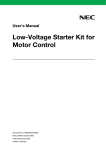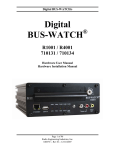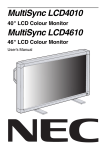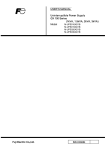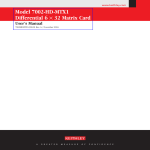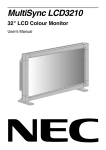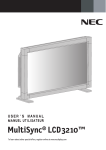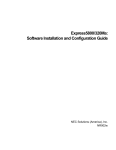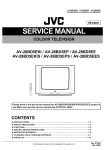Download 3 phase motor control high voltage inverter module
Transcript
User's Manual 3 Phase Motor Control High Voltage Inverter Module Document No. U17811EE2V0UM00 Date published October 2007 © NEC Electronics 2007 Printed in Germany Legal Notes 2 • The information in this document is current as of August, 2007. The information is subject to change without notice. For actual design-in, refer to the latest publications of NEC Electronics data sheets or data books, etc., for the most up-to-date specifications of NEC Electronics products. Not all products and/or types are available in every country. Please check with an NEC Electronics sales representative for availability and additional information. • No part of this document may be copied or reproduced in any form or by any means without the prior written consent of NEC Electronics. NEC Electronics assumes no responsibility for any errors that may appear in this document. • NEC Electronics does not assume any liability for infringement of patents, copyrights or other intellectual property rights of third parties by or arising from the use of NEC Electronics products listed in this document or any other liability arising from the use of such products. No license, express, implied or otherwise, is granted under any patents, copyrights or other intellectual property rights of NEC Electronics or others. • Descriptions of circuits, software and other related information in this document are provided for illustrative purposes in semiconductor product operation and application examples. The incorporation of these circuits, software and information in the design of a customer's equipment shall be done under the full responsibility of the customer. NEC Electronics assumes no responsibility for any losses incurred by customers or third parties arising from the use of these circuits, software and information. • While NEC Electronics endeavors to enhance the quality, reliability and safety of NEC Electronics products, customers agree and acknowledge that the possibility of defects thereof cannot be eliminated entirely. To minimize risks of damage to property or injury (including death) to persons arising from defects in NEC Electronics products, customers must incorporate sufficient safety measures in their design, such as redundancy, fire-containment and anti-failure features. • NEC Electronics products are classified into the following three quality grades: "Standard", "Special" and "Specific". • The "Specific" quality grade applies only to NEC Electronics products developed based on a customer-designated "quality assurance program" for a specific application. The recommended applications of an NEC Electronics product depend on its quality grade, as indicated below. Customers must check the quality grade of each NEC Electronics product before using it in a particular application. "Standard": Computers, office equipment, communications equipment, test and measurement equipment, audio and visual equipment, home electronic appliances, machine tools, personal electronic equipment and industrial robots. "Special": Transportation equipment (automobiles, trains, ships, etc.), traffic control systems, anti-disaster systems, anti-crime User's Manual U17811EE2V0UM00 systems, safety equipment and medical equipment (not specifically designed for life support). "Specific": Aircraft, aerospace equipment, submersible repeaters, nuclear reactor control systems, life support systems and medical equipment for life support, etc. The quality grade of NEC Electronics products is "Standard" unless otherwise expressly specified in NEC Electronics data sheets or data books, etc. If customers wish to use NEC Electronics products in applications not intended by NEC Electronics, they must contact an NEC Electronics sales representative in advance to determine NEC Electronics' willingness to support a given application. (Note) (1) "NEC Electronics" as used in this statement means NEC Electronics Corporation and also includes its majority-owned subsidiaries. (2) "NEC Electronics products" means any product developed or manufactured by or for NEC Electronics (as defined above). User's Manual U17811EE2V0UM00 3 Notes for CMOS Devices 4 1. VOLTAGE APPLICATION WAVEFORM AT INPUT PIN Waveform distortion due to input noise or a reflected wave may cause malfunction. If the input of the CMOS device stays in the area between VIL (MAX) and VIH (MIN) due to noise, etc., the device may malfunction. Take care to prevent chattering noise from entering the device when the input level is fixed, and also in the transition period when the input level passes through the area between VIL (MAX) and VIH (MIN). 2. HANDLING OF UNUSED INPUT PINS Unconnected CMOS device inputs can result in malfunction. If an input pin is unconnected, it is possible that an internal input level may be generated due to noise, etc., causing malfunction. CMOS devices behave differently than Bipolar or NMOS devices. Input levels of CMOS devices must be fixed high or low by using pull-up or pulldown circuitry. Each unused pin should be connected to VDD or GND via a resistor if there is a possibility that it will be an output pin. All handling related to unused pins must be judged separately for each device and according to related specifications governing the device. 3. PRECAUTION AGAINST ESD A strong electric field, when exposed to a MOS device, can cause destruction of the gate oxide and ultimately degrade the device operation. Steps must be taken to stop generation of static electricity as much as possible, and to quickly dissipate it should it occur. Environmental control must be adequate. When it is dry, a humidifier should be used. It is recommended to avoid using insulators that easily build up static electricity. Semiconductor devices must be stored and transported in an anti-static container, static shielding bag or conductive material. All test and measurement tools including work benches and floors should be grounded. The operator should be grounded using a wrist strap. Semiconductor devices must not be touched with bare hands. Similar precautions need to be taken for PW boards with mounted semiconductor devices. 4. STATUS BEFORE INITIALIZATION Power-on does not necessarily define the initial status of a MOS device. Immediately after the power source is turned ON, devices with reset functions have not yet been initialized. Hence, power-on does not guarantee output pin levels, I/O settings or contents of registers. A device is not initialized until the reset signal is received. A reset operation must be executed immediately after power-on for devices with reset functions. 5. POWER ON/OFF SEQUENCE In the case of a device that uses different power supplies for the internal operation and external interface, as a rule, switch on the external power supply after switching on the internal power supply. When switching the power supply off, as a rule, switch off the external power supply and then the internal power supply. Use of the reverse power on/off sequences may result in the application of an overvoltage to the internal elements of the device, causing malfunction and degradation of internal elements due to the passage of an abnormal current. The correct power on/off sequence must be User's Manual U17811EE2V0UM00 judged separately for each device and according to related specifications governing the device. 6. INPUT OF SIGNAL DURING POWER OFF STATE Do not input signals or an I/O pull-up power supply while the device is not powered. The current injection that results from input of such a signal or I/O pull-up power supply may cause malfunction and the abnormal current that passes in the device at this time may cause degradation of internal elements. Input of signals during the power off state must be judged separately for each device and according to related specifications governing the device. User's Manual U17811EE2V0UM00 5 Regional Information Some information contained in this document may vary from country to country. Before using any NEC product in your application, please contact theNEC office in your country to obtain a list of authorized representatives anddistributors. They will verify: • Device availability • Ordering information • Product release schedule • Availability of related technical literature • Development environment specifications (for example, specifications for third-party tools and components, host computers, power plugs, AC supply voltages, and so forth) • Network requirements In addition, trademarks, registered trademarks, export restrictions, and otherlegal issues may also vary from country to country. NEC Electronics Corporation 1753, Shimonumabe, Nakahara-ku, Kawasaki, Kanagawa 211-8668, Japan Tel: 044 4355111 http://www.necel.com/ [America] [Europe] [Asia & Oceania] NEC Electronics America, Inc. 2880 Scott Blvd. Santa Clara, CA 95050-2554, U.S.A. Tel: 408 5886000 http://www.am.necel.com/ NEC Electronics (Europe) GmbH Arcadiastrasse 10 40472 Düsseldorf, Germany Tel: 0211 65030 http://www.eu.necel.com/ NEC Electronics (China) Co., Ltd 7th Floor, Quantum Plaza, No. 27 ZhiChunLu Haidian District, Beijing 100083, P.R.China Tel: 010 82351155 http://www.cn.necel.com/ United Kingdom Branch Cygnus House, Sunrise Parkway Linford Wood, Milton Keynes MK14 6NP, U.K. Tel: 01908 691133 Succursale Française 9, rue Paul Dautier, B.P. 52 78142 Velizy-Villacoublay Cédex France Tel: 01 30675800 Sucursal en España Juan Esplandiu, 15 28007 Madrid, Spain Tel: 091 5042787 Tyskland Filial Täby Centrum Entrance S (7th floor) 18322 Täby, Sweden Tel: 08 6387200 6 NEC Electronics Shanghai Ltd. Room 2511-2512, Bank of China Tower, 200 Yincheng Road Central, Pudong New Area, Shanghai 200120, P.R. China Tel: 021 58885400 http://www.cn.necel.com/ NEC Electronics Hong Kong Ltd. 12/F., Cityplaza 4, 12 Taikoo Wan Road, Hong Kong Tel: 2886 9318 http://www.hk.necel.com/ NEC Electronics Taiwan Ltd. 7F, No. 363 Fu Shing North Road Taipei, Taiwan, R.O.C. Tel: 02 27192377 Filiale Italiana Via Fabio Filzi, 25/A 20124 Milano, Italy Tel: 02 667541 NEC Electronics Singapore Pte. Ltd. 238A Thomson Road, #12-08 Novena Square, Singapore 307684 Tel: 6253 8311 http://www.sg.necel.com/ Branch The Netherlands Steijgerweg 6 5616 HS Eindhoven, The Netherlands Tel: 040 2654010 NEC Electronics Korea Ltd. 11F., Samik Lavied’or Bldg., 720-2, Yeoksam-Dong, Kangnam-Ku, Seoul, 135-080, Korea Tel: 02-558-3737 http://www.kr.necel.com/ User's Manual U17811EE2V0UM00 Preface Readers This manual is intended for users who want to understand the functions of the 3Phase Inverter Starter Kit Module supporting NEC Electronics' range of Motor Control ASSPs. Purpose This manual presents the hardware manual of the 3-Phase Inverter Starter Kit Module supporting NEC Electronics' range of Motor Control ASSPs. Organization This system specification describes the following sections: • • • • • Legend Symbols and notation are used as follows: • • • • • Note Caution Numeric Notation Prefixes Inverter module IGBT module Opto isolation Power supplies User connections Weight in data notation: Left is high order column, right is low order column Active low notation: xxx (pin or signal name is over-scored) or /xxx (slash before signal name) Memory map address: High order at high stage and low order at low stage Note: Caution: Additional remark or tip Item deserving extra attention • • • Binary: xxxx or xxxB Decimal: xxxx Hexadecimal: xxxxH or 0x xxxx representing powers of 2 (address space, memory capacity): • • • K (kilo): 210 = 1024 M (mega): 220 = 10242 = 1,048,576 G (giga): 230 = 10243 = 1,073,741,824 User's Manual U17811EE2V0UM00 7 Table of Contents Chapter 1 Introduction ....................................................... 9 1.1 Warnings . . . . . . . . . . . . . . . . . . . . . . . . . . . . . . . . . . . . . . . . . . . . . . . . . . . . . . . . . . . . . . . . . . . . . . . . . 9 1.2 Precautions . . . . . . . . . . . . . . . . . . . . . . . . . . . . . . . . . . . . . . . . . . . . . . . . . . . . . . . . . . . . . . . . . . . . . . . 10 Chapter 2 Definitions . . . . . . . . . . . . . . . . . . . . . . . . . . . . . . . . . . . . . . . . . . . . . . . . . . . . . . . . . . 11 2.1 Overview . . . . . . . . . . . . . . . . . . . . . . . . . . . . . . . . . . . . . . . . . . . . . . . . . . . . . . . . . . . . . . . . . . . . . . . . . 11 2.2 Equipment Ratings . . . . . . . . . . . . . . . . . . . . . . . . . . . . . . . . . . . . . . . . . . . . . . . . . . . . . . . . . . . . . . . . 11 Chapter 3 Inverter Module Chapter 4 IGBT Module 4.1 . . . . . . . . . . . . . . . . . . . . . . . . . . . . . . . . . . . . . . . . . . . . . . . . . . 13 . . . . . . . . . . . . . . . . . . . . . . . . . . . . . . . . . . . . . . . . . . . . . . . . . . . . . . 14 Specifications . . . . . . . . . . . . . . . . . . . . . . . . . . . . . . . . . . . . . . . . . . . . . . . . . . . . . . . . . . . . . . . . . . . . 4.1.1 IGBT Driver Maximum Operating Conditions . . . . . . . . . . . . . . . . . . . . . . . . . . . . . . . . . . 4.1.2 IGBT Module Thermal Characteristics . . . . . . . . . . . . . . . . . . . . . . . . . . . . . . . . . . . . . . . 4.1.3 Module Shutdown . . . . . . . . . . . . . . . . . . . . . . . . . . . . . . . . . . . . . . . . . . . . . . . . . . . . . . . . . Chapter 5 Opto Isolation . . . . . . . . . . . . . . . . . . . . . . . . . . . . . . . . . . . . . . . . . . . . . . . . . . . . . 14 14 16 17 18 5.1 Isolation Block Diagrams . . . . . . . . . . . . . . . . . . . . . . . . . . . . . . . . . . . . . . . . . . . . . . . . . . . . . . . . . . 19 5.2 Analogue Isolation Circuit Description . . . . . . . . . . . . . . . . . . . . . . . . . . . . . . . . . . . . . . . . . . . . . . 5.2.1 Functional Description - Current Measurement . . . . . . . . . . . . . . . . . . . . . . . . . . . . . . . 5.2.2 Functional Description - Zero Crossing Detection . . . . . . . . . . . . . . . . . . . . . . . . . . . . . 5.2.3 Functional Description - Inverter Motor Terminal Voltages . . . . . . . . . . . . . . . . . . . . . . 5.2.4 Functional Description - IGBT Temperature Sensor . . . . . . . . . . . . . . . . . . . . . . . . . . . . Chapter 6 Power Supplies . . . . . . . . . . . . . . . . . . . . . . . . . . . . . . . . . . . . . . . . . . . . . . . . . . . 19 20 21 21 22 23 6.1 Overview . . . . . . . . . . . . . . . . . . . . . . . . . . . . . . . . . . . . . . . . . . . . . . . . . . . . . . . . . . . . . . . . . . . . . . . . . 23 6.2 Mains Input . . . . . . . . . . . . . . . . . . . . . . . . . . . . . . . . . . . . . . . . . . . . . . . . . . . . . . . . . . . . . . . . . . . . . . . 23 6.2.1 Mains Selection Options . . . . . . . . . . . . . . . . . . . . . . . . . . . . . . . . . . . . . . . . . . . . . . . . . . . 24 Chapter 7 User Connections . . . . . . . . . . . . . . . . . . . . . . . . . . . . . . . . . . . . . . . . . . . . . . . 26 7.1 Motor Terminal Connections . . . . . . . . . . . . . . . . . . . . . . . . . . . . . . . . . . . . . . . . . . . . . . . . . . . . . . . 27 7.2 Motor Selection . . . . . . . . . . . . . . . . . . . . . . . . . . . . . . . . . . . . . . . . . . . . . . . . . . . . . . . . . . . . . . . . . . . 28 7.2.1 Induction Motor . . . . . . . . . . . . . . . . . . . . . . . . . . . . . . . . . . . . . . . . . . . . . . . . . . . . . . . . . . . 29 7.2.2 Brushless DC Motor . . . . . . . . . . . . . . . . . . . . . . . . . . . . . . . . . . . . . . . . . . . . . . . . . . . . . . . 29 Chapter 8 8 Appendices . . . . . . . . . . . . . . . . . . . . . . . . . . . . . . . . . . . . . . . . . . . . . . . . . . . . . . . . 30 User's Manual U17811EE2V0UM00 Chapter 1 Introduction This document details the operation, interfaces and cautions for the 3Φ Inverter Starter Kit Module supporting NEC Electronics’ range of Motor Control ASSPs. The module is designed to support 3Φ Brushless DC, 3Φ PMAC and 3Φ AC Induction motor types. 1.1 Warnings This high voltage starter kit Inverter unit operates in an environment that includes dangerous voltages and rotating machinery. Care should be taken when using the unit especially if the unit is removed from the case. • • • • • • When switching off the mains supply, stored energy will remain in the high voltage capacitors. It is necessary to wait at least 50 seconds after disconnecting the mains supply, before disconnecting any of the attached equipment (i.e. The Motor or Control Boards), or before opening the case. Switching on the module without ensuring that the high voltage supplies have fully discharged and that the drive signal are in the “OFF” state is liable to cause damage to the unit. Bias resistors are provided to ensure correct polarity of these signals if the unit is inadvertently switched on without any control boards connected. Ensure that the input voltage selector is set for the correct AC Mains voltage range. Incorrect setting of the switch for the mains supply used will cause damage to the unit For continued protection against risk of fire only replace fuses with the same type and rating (T6.3A / 250V). Repairs may only be attempted by authorised personnel. Repairs performed inappropriately and changes or modifications not explicitly allowed by the equipment's manufacturer may cause damage to the unit and severe danger to the user. The Power Module and the motor can reach temperatures hot enough to cause burns. Care should be taken to avoid touching the motor or removing the case after prolonged operation. User's Manual U17811EE2V0UM00 9 Chapter 1 Introduction 1.2 Precautions The following precautions should be taken and used in conjunction with the following sections of this document • • • • • • • Note The Inverter units is not intended for use without the case • • • 10 The intended use of this inverter module is as test and measuring equipment for use in electronic development offices or laboratories and used by appropriate professionals When operating from an AC Mains supply without an Isolation Transformer, please be aware that the Power Stage grounds and external ground (i.e. oscilloscope, Control Board etc.) will be at different potentials. Note that if an un-earthed oscilloscope is used, the probe ground references and the case can be subject to dangerous voltages. Before moving scope probes, making connections, etc., it is generally advisable to power down the high-voltage supply and ensure that it is fully discharged. Care should be taken with Jewellery and other loose items and the use of a protective shield is advisable. Operation in lab setups that have grounded tables and / or chairs should be avoided. The power cord plug must be easily accessible at any time so that it can be disconnected immediately in case of danger. If the circuit board has been removed from the case, ensure that the cables are reconnected to the correct connectors when it is reassembled. All applications should utilise the Over Current and Thermal Protection capabilities to protect the IGBT module and motor. Ensure that all connections and settings to the unit are correct before operation, to avoid possible damage to the components and / or the motor. Ensure that the correct settings are used for the appropriate Motor rating ( "see section Equipment Ratings") User's Manual U17811EE2V0UM00 Chapter 2 Definitions 2.1 Overview The high voltage Inverter unit forms part of the overall Motor Control starter kit products, which consist of 3 component parts (see figure 1). 1. 2. 3. A Motor control ASSP microcontroller board A user interface and I/O board A 3Φ high voltage Inverter Module including Power supplies and Opto-Isolation The boards are designed in such a way that they maybe used individually or as a kit. Please note that the high voltage unit will only available separately. The other component parts can be purchased separately. Figure 2-1 3Φ Motor Control Starter Kit – Inverter Module Connection to the Microcontroller and I/O boards is via the 40 way interface connector shown on the side of the case. All interfaces, mains power input, motor connections and selectable options provided ensure that the user is protected from the high voltage areas. The unit is not intended for use without the case. 2.2 Equipment Ratings The unit is designed to operate over the following electrical and environmental conditions User's Manual U17811EE2V0UM00 11 Chapter 2 Definitions Table 2-1 Table 2-2 Table 2-3 Table 2-4 12 Mains Input Ratings Specification Rating Input voltage 100 VAC to 240 VAC Input current 3A Mains Frequency 50 - 60 Hz Mains connection Appliance inlet (Type - IEC320) Output Ratings Specification Rating Output voltage 130 Vdc to 350 Vdc Output power 300 / 600 W (max.) Protection Levels Specification Rating Protection Class 1 Transient voltage Category 2 Pollution degree Level 2 Operating Conditions Specification Rating Operating temperature range +5°C to +35°C Storage temperature range -40 to +70°C Operating relative humidity 20% to 80% Storage relative humidity 5% to 85% User's Manual U17811EE2V0UM00 Chapter 3 Inverter Module The high voltage Inverter unit contains the following sections: 1. 2. 3. 4. The High Voltage 3Φ IGBT Bridge Module All the necessary Power Supplies Opto-isolation for the logic drive and logic level sensor signals Opto-isolation for the analogue sensor signals This unit includes all of the necessary power supplies and inverter circuitry for controlling a 3Φ motor. It provides all necessary current and voltage measurement circuits and signal conditioning circuits required for motor control. The module rectifies 100V to 220V AC mains voltage to the high voltage unregulated DC supply for the Inverter bridge module. The +5V and +15V regulated DC supplies for the control and interface circuits are generated from the unregulated DC supply The inverter bridge uses an integrated 6 transistor IGBT module, which includes high side drivers and protection circuitry. Figure 3-1 Inverter Module block diagram User's Manual U17811EE2V0UM00 13 Chapter 4 IGBT Module The 3Φ IGBT module provides all of the six transistor drive for the Motor together with the integrated high side driver and protection functions. The IGBT module used on the is supplied by International Rectifier, part number “IRAMS10UP60A” Features • • • • • • • • • • • Integrated Gate Drivers and Bootstrap Diodes Temperature Monitor Temperature and Over current shutdown Fully Isolated Package Low VCE (on) Non Punch Through IGBT Technology Under-voltage lockout for all channels Matched propagation delay for all channels Low side IGBT emitter pins for current control Schmitt-triggered input logic Cross-conduction prevention logic Lower di / dt gate driver for better noise immunity 4.1 Specifications A summary of the specifications of the IGBT module is as follows. (For full specifications and recommended use of the IGBT module specifications, please refer to manufacturer’s data sheet and the Inverter module reference schematics) 4.1.1 IGBT Driver Maximum Operating Conditions Table 4-1 14 Maximum IGBT Module Operating Conditions Symbol Definition Min Max Units Vh High Side Floating Supply Voltage Vs + 12 Vs + 20 V Vs High Side Supply Offset Voltage 450 V Vdd Low Side Logic / Fixed Supply Voltage 12 20 V Vtrip T/Itrip input voltage Vss Vss +5 V Vin Logic Input Voltage (Lin / Hin) Vss Vss +5 V User's Manual U17811EE2V0UM00 IGBT Module Chapter 4 Typical IGBT Driver Switching Characteristics VDD=VBS=VBIAS=15V, Io=1A, VD=9V, TA=25°C Table 4-2 Table 4-3 Note Typical IGBT Module Switching Conditions Symbol Definition Value (Typ) Units Ton Input to Output turn On delay time 470 nS Toff Input to Output turn off delay time 615 nS Dt Dead time 300 nS Itrip T/Itrip turn off delay time 750 nS T Post Itrip to turn off clear time 9 mS IGBT Module Pin Connections Pin Name Description 1 VB3 High Side Floating Supply Voltage 3 2 W, VS3 Output 3 - High Side Floating Supply Offset Voltage 3 na None 4 VB2 High Side Floating Supply Voltage 2 5 V, VS2 Output 2 - High Side Floating Supply Offset Voltage 6 na None 7 VB1 High Side Floating Supply Voltage 1 8 U, VS1 Output 1 - High Side Floating Supply Offset Voltage 9 na None 10 V+ Positive Bus Input Voltage 11 na None 12 LE1 Low Side Emitter Connection - Phase 1 13 LE2 Low Side Emitter Connection - Phase 2 14 LE3 Low Side Emitter Connection - Phase 3 15 HIN1 Logic Input High Side Gate Driver - Phase 1 16 HIN2 Logic Input High Side Gate Driver - Phase 2 17 HIN3 Logic Input High Side Gate Driver - Phase 3 18 LIN1 Logic Input Low Side Gate Driver - Phase 1 19 LIN2 Logic Input Low Side Gate Driver - Phase 2 20 LIN3 Logic Input Low Side Gate Driver - Phase 3 21 T/Itrip Temperature Monitor and Shut-down Pin 22 VCC +15V Main Supply 23 VSS Negative Main Supply The PWM drive input from the Microcontroller / I/O board should be set to “Active Low”. All 6 channels of the PWM timer should be used (i.e. HiU, LoU, HiV, LoV, HiW, LoW) The circuit schematic for the IGBT module is as shown in Appendix B User's Manual U17811EE2V0UM00 15 Chapter 4 IGBT Module 4.1.2 IGBT Module Thermal Characteristics As can be seen in figure 3 below, the IGBT module provides an internal over temperature monitor which can be combined with a hardware shutdown function. The module may need to be shutdown for either of the following reasons 1. 2. Over temperature Over current detection Current detection and monitoring is described later in this document. The use of the TSENSE / ITRIP pin can be used to protect the IGBT module for both over temperature or over current events. Figure 4-1 Internal NTC–Connection Diagram Temperature Sensing and Measurement The temperature output (TSENSE / ITRIP) from the IGBT module (shown in Figure 4-1 ), is provided to the user interface as an isolated analogue signal (TEMP – ST1 pin 9) in the range 0V to 3.3V. The isolation circuit provides a unity gain stage, so that the temperature can effectively be monitored directly from the IGBT module (See the graph of Figure 4-2 ). This enables the control system to monitor this parameter to ensure that the IGBT module does not overheat. 16 User's Manual U17811EE2V0UM00 IGBT Module Chapter 4 Figure 4-2 Internal NTC-Thermistor Characteristics Please note that the Analogue reference voltages of the A/D converter on the microcontroller ASSP boards are set to Vdd (5V). So the maximum threshold of the analogue input (TEMP) is 66% of the analogue reference voltage (i.e. 3.3V / 5V). To change the ADC reference voltage, please refer to the Microcontroller ASSP board circuit schematics. 4.1.3 Module Shutdown The module can be shut down by the control system either with the hardware shutdown signal (TRIP – ST1 pin 19), or stopping the PWM drive signals to the IGBT module by software (Ideally both methods should be used). The Inverter unit employs an automatic over current /temperature detection circuit which is designed shutdown the IGBT module automatically. Please note that this function is designed as “latching” circuit, so once tripped (i.e. shutdown) it will remain unit the main power to the unit is switched off and the high voltage capacitors discharged. The automatic IGBT shutdown function is enabled as the default manufacturing condition. It can be disabled by removing Jumper “W5”. User's Manual U17811EE2V0UM00 17 Chapter 5 Opto Isolation Overview Isolation is provided for all digital and Analogue signals between the low voltage Microcontroller / I/O boards and the high voltage power electronics for the motor. Figure 5-1 Opto-Isolation The PCB layout in Figure 5-1 above is shown removed from the case for illustration purposes only. Operation of the unit should always be with the PCB mounted inside the case. The circuit schematics for the Analogue and Digital isolation are shown in Appendices B and C The isolation scheme is as shown in Figure 5-2 below. 18 User's Manual U17811EE2V0UM00 Opto Isolation Chapter 5 5.1 Isolation Block Diagrams Figure 5-2 Analogue and Digital Opto-isolation Stages The Opto-isolation for the digital I/O signals provide a “Non Inverting” signal conversion. 5.2 Analogue Isolation Circuit Description The following section describes the functions and operation of the analogue isolation circuitry providing feedback and monitoring functions to the microcontroller control system. The functions provided by the analogue isolation circuits are as follows 1. Three zero crossing detection comparator circuits for BLDC Sensor less control User's Manual U17811EE2V0UM00 19 Chapter 5 Opto Isolation 2. 3. 4. 5. 6. 7. An isolated over current input to the control system (Digital Input to the control system). (This function can also be used for automatic hardware over current shutdown of the IGBT module.) Current measurement of each phase Total current monitor (combined with item 2 above) IGBT module Temperature sensor output Voltage monitor for each phase High Voltage monitor (+350 VP) 5.2.1 Functional Description - Current Measurement The current measurement circuits provide an analogue “shunt” measurement for each phase together with a total current measurement function. The individual current measurement circuits operate over a range of 0A to 3A per phase, which is converted to an output voltage in the range of 0V to 5V full scale. This provides an output conversion ratio of 600mA / V The total current measurement circuit provides an input range of 0A to 3A, providing an output range of 0V to 5V full scale. Figure 5-3 Current Measurement Transfer Function The total current measurement is also converted into a digital output (ITRIP), to provide a hardware shutdown signal for the 6 PWM outputs from the Microcontroller. The polarity of the “ITRIP” signal is 1. 2. 20 0V Normal Operation 5V Over current (i.e. Shutdown condition @ 3A) User's Manual U17811EE2V0UM00 Opto Isolation Chapter 5 Automatic shut down of the IGBT module is provided by ensuring that Jumper “W5” is connected (Default manufacture setting). This is a “latching” function, so that once triggered (i.e. Shutdown), the mains power to the unit must be switched off and allowed to discharge. Once fully discharged, the mains power can be re applied to the unit. (Assuming that the cause of the fault condition has been fixed) It is advisable to stop the operation of the Microcontroller ASSP during this operation Note The hardware PWM shutdown input of the micro controller needs to be set for +Ve edge triggering, or active high level. The signals are provided on the 40 way interface connector (ST1) are as shown below 1. 2. 3. 4. 5. Signal IW IV IU ISHUNT ITRIP Pin Number ST1 pin 36 ST1 pin 38 ST1 pin 40 ST1 pin 34 ST1 pin 39 Comments (Phase W current Analogue Output) (Phase V current Analogue Output) (Phase U current Analogue Output) (Total current Analogue Output) (Over current Digital Output) 5.2.2 Functional Description - Zero Crossing Detection The zero crossing detection circuits consist of comparator circuits with input signal conditioning and filtering components. The design of these circuits is to provide a zero crossing detection of the motor BEMF signals (The schematic diagrams of these functions are included in Appendix C). The output of the isolated signals provides a logic level drive (0v – 5V) for the control system. These signals are provided on the interface connector as shown below. Signal 1. CMPW 2. CMPV 3. CMPU Pin Number ST1 pin 24 ST1 pin 26 ST1 pin 28 Comments (Phase W Zero Crossing) (Phase V Zero Crossing) (Phase U Zero Crossing) 5.2.3 Functional Description - Inverter Motor Terminal Voltages The isolation circuits for the three Motor Phase voltages provide input signal conditioning and conversion from the high voltage PWM inverter voltage to that of an analogue output. This also includes an output indicating the High Voltage inverter supply level. These signals in the range of 1. 2. Input Voltage Range 0V to 375V Isolated Output Voltage Range 0V to 5V This provides a conversion ratio of 75V / V The schematic diagrams for these circuits are included in Appendix C These signals are provided on the interface connector as shown below Signal 1. V-W 2. V-V Pin Number ST1 pin 2 ST1 pin 4 User's Manual U17811EE2V0UM00 Comments (Phase W Terminal Voltage) (Phase V Terminal Voltage) 21 Chapter 5 Opto Isolation 3. V-U ST1 pin 6 4. V_DCLINK ST1 pin 37 (Phase U Terminal Voltage) (Inverter Supply Voltage +350VP) 5.2.4 Functional Description - IGBT Temperature Sensor The output from the IGBT module is converted into an analogue voltage with unity gain levels. The output level is in the range of 0V to 3.3V. The maximum operating level is 3.3V. This provides an approximate conversion of 36.3oC per Volt. (See Figure 4-2 ) Signal 1. TEMP 22 Pin Number ST1 pin 32 User's Manual U17811EE2V0UM00 Comments (IGBT Temperature Voltage) Chapter 6 Power Supplies 6.1 Overview The power supply is designed to provide the unregulated DC supply for the IGBT and motor, as well as regulated DC supplies for the isolated side of the inverter unit. The regulated supplies provide power for the, Opto-isolation circuits and the low voltage supply for the IGBT module (+15V). Supplies available on the module are: 1. 2. Regulated +5V and +15V DC 330mA Total Unregulated +350V DC 3A Total The on board power supplies only provide power to the un-isolated (i.e. high voltage) side of the unit. An external +5V DC supply is needed to supply power to the isolated side. This can be supplied directly from the Microcontroller / I/O boards or the users target control system via the interface connector ST1. The unit is able to support 100V, 110V and 240V mains input voltages, while designed to supply the maximum motor voltage. The Inverter unit employs a voltage doubler circuit, so it is important that the correct mains supply setting is selected using switch “S1” to avoid damage to the Inverter and possibly the motor. The circuit schematic for the Power supply is as shown in Appendix A Note The +5V DC supply is derived from the +15V supply, thus the maximum power supply current indicated above is a combined total. 6.2 Mains Input The power input is designed to be connected using a standard Mains cable to the IEC320 switched appliance inlet, as shown in Figure 6-1 below. User's Manual U17811EE2V0UM00 23 Chapter 6 Power Supplies Figure 6-1 Mains Power Input The AC mains input provides a switched, filtered and fused supply to the board. Please ensure that if it is necessary to replace either of the two fuses, that they are replaced with the same type and rating. (T6.3A / 250V) In order to select the correct mains input voltage a switch (S1) is provided on the side of the case as shown in Figure 6-2 . Warning ! Ensure that the mains selection switch (S1) is set to the correct setting before connecting and switching on the unit. An incorrect setting of this switch could cause damage to the unit. See "section" below and Table 6-1 below for the correct settings. 6.2.1 Mains Selection Options The module is designed to provide the maximum motor voltage from either a 100V, 110V or 240V mains supply. The power supply includes an AC voltage doubler circuit, so it is important that the correct AC voltage setting is used when operating the units outside of Europe or when using lower rated motors that require a lower AC supply voltage. The location of the switch is a shown in Figure 6-2 below 24 User's Manual U17811EE2V0UM00 Power Supplies Figure 6-2 Chapter 6 AC Mains Input Selection If a motor is used that that requires a lower voltage (i.e. 150Vdc (110Vac)), then the Inverter board should be set for 240V mains input (no doubling) via the switch S1. If necessary, an external step down transformer should be used to provide the appropriate mains input supply. Other valid input combinations are available for the selection of AC Mains voltage and rectified DC motor voltage. The table below shows the possible options for AC mains input and rectified DC voltage Table 6-1 Caution AC Mains and DC Motor Voltage Valid Switch Combinations AC Mains Input Switch (S1) Selection Equivalent AC Voltage DC Motor Voltage 100V 110V ~200V 283V 100V 240V 100V 142V 110V 110V ~220V 311V 110V 240V 110V 156V 240V 240V ** 240V 340V 240V 110V** Not Allowed Not Allowed The only option for 240V AC mains input is with the Switch (S1) set to 240V. Any other setting will damage the unit. User's Manual U17811EE2V0UM00 25 Chapter 7 User Connections The main connection between the Inverter unit and the Microcontroller / IO board (or user control board) is as shown in Figure 7-1 below. Figure 7-1 Control Interface The signal connection between the Inverter module and the microcontroller / IO board is as shown in Figure 7-2 below. 26 User's Manual U17811EE2V0UM00 User Connections Figure 7-2 Chapter 7 Control Interface Signal Allocation (ST1) 7.1 Motor Terminal Connections The connections to the Motor are provided via connector located on the Inverter unit as shown below. The connector provides full mechanical isolation from the high motor voltages User's Manual U17811EE2V0UM00 27 Chapter 7 User Connections Figure 7-3 Motor Terminal Interface The connections to the motor are as shown in Table 7-1 below Table 7-1 Motor Terminal Connections Pin Number Function Pin 1 Phase Voltage W (Vw) Pin 2 Phase Voltage V (Vv) Pin 3 Phase Voltage U (Vu) 7.2 Motor Selection Detailed below are the two reference 3Φ motors that were used to develop application examples for the Inverter module. The motors are not included with the Inverter unit, but can be supplied by the appropriate manufacturer or distributor, as required. The user is able to use an alternative motor, which may be more suited to their end application. Note 28 No changes need to be made on the Inverter unit from the default (Factory) settings in order to use the example motors and associated software. If alternate 3Φ motors are used the demonstration software available will need to be adapted to the new motor parameters User's Manual U17811EE2V0UM00 User Connections Chapter 7 7.2.1 Induction Motor A Reference 3Φ Induction motor was used with the Inverter module, to provide an example application using Space Vector Modulation. The Speed feedback is provided by an external Incremental Encoder added to the Rotor spindle, in order to show the capability of the appropriate microcontrollers. Please note that the example application software is liable to change as more Motor control microcontrollers are developed. An outline of the reference motor parameters are described below 1. 2. 3. 4. ABB 3Φ 2 pole, General Purpose Squirrel Cage Induction Motor Motor Type - M2VA56A (Product Code- 3GVA051 001-ASA) 400V, 50Hz Maximum Rated Speed 4,000 RPM The incremental encoder used with the ABB reference motor is 1. 2. Hohner Automation Incremental Encoder type: 0710-13DR-0256 256 Pulses per Revolution The encoder was used primarily to provide speed indication of the motor. It can however, be used in conjunction with an appropriate timer on the Microcontroller as a full “incremental encoder function” (i.e. both direction and speed measurement) 7.2.2 Brushless DC Motor A reference 3Φ Brushless DC motor was used with the Inverter module, to provide an example Sensored and Sensorless demonstration application. The sensored application uses the three Hall sensors mounted in the motor, providing speed and position feedback for the Microcontroller. The Sensorless application uses the same control software design, but uses the three zero crossing comparators instead of the Hall sensors to provide as the speed and position feedback to the Microcontroller. An outline of the motor parameters are described below 1. 2. 3. 4. 5. Oriental 3Φ BLDC Motor - 4 pole, 75 Watt Part Number:- FBLM575W-A 150V Maximum Rated Speed 4,000 RPM 3 x Integrated Hall Sensors (2 pulses per revolution / sensor) User's Manual U17811EE2V0UM00 29 Chapter 8 Appendices This document contains file attachments. Use the Attachments tab to see them. 30 User's Manual U17811EE2V0UM00




































